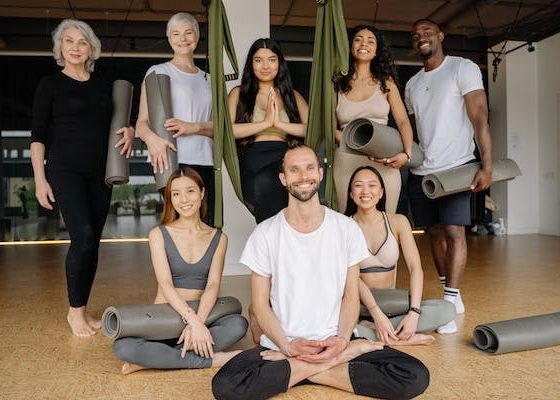We all wanted to be physically fit, having the curves, the packs, and the bare perfection. Yet, it is a struggle to strive for fitness when we need more knowledge and motivation. Our time has become so hectic that we can’t set a schedule for fitness exercises. So, instead of trying, our bodies stagnated. Especially now, when we are too busy to prepare home-cooked meals, we run into food chains and ready-to-eat foods to fill our stomachs, which unknowingly become an addition to our unhealthy habits. Hence, to end the cycle, we’ll help you with your fitness goals as we will give you an excellent overview of 2024 fitness exercises for motivation and guidelines.
Current Guidelines and Recommendations for 2024 Fitness Exercises:
International Standards and Guidelines
Renowned global health organizations like the World Health Organization (WHO) and the American Heart Association have outlined comprehensive guidelines for exercise. These recommendations typically advocate for a minimum amount of moderate-to-vigorous physical activity per week.
The Science Behind Exercise Recommendations
The guidelines are not arbitrary; they are grounded in physiological understanding. Physical activity triggers a cascade of bodily benefits, affecting cardiovascular, musculoskeletal, and neurological systems and enhancing overall health.
Understanding the Foundation of Fitness Exercise
Exercise forms the cornerstone of a healthy lifestyle, encompassing a spectrum of physical activities contributing to overall well-being. Exercise catalyzes improved health, any movement that engages the body and elevates energy expenditure.
The Evolving Notion of Fitness
Throughout history, the perception of fitness has evolved significantly. From ancient civilizations valuing physical prowess to the modern era’s emphasis on holistic well-being, the definition of fitness has undergone a metamorphosis, encompassing physical strength and mental and emotional vitality.
Personalized Approaches for Fitness Goals:
Tailoring Exercise to Individual Needs
Recognizing the individuality of fitness requirements is crucial. Age, health conditions, and personal goals significantly influence the amount and type of exercise needed for optimal health.
Customizing Exercise Routines
An individualized workout plan considers fitness goals, time availability, and preferences. Tailoring exercises to fit one’s lifestyle enhances adherence and maximizes results.

Different Forms of 2024 Fitness Exercises:
Cardiovascular Exercise
Cardiovascular cardio or aerobic exercise is vital for maintaining good health by elevating your heart rate and increasing blood circulation, delivering oxygen throughout your body to promote heart and lung health. Regular cardio can aid in weight loss, enhance sleep patterns, and reduce the likelihood of chronic ailments.
From beginner to advanced levels, you can perform various cardio exercises at home, such as high knees, squat jumps, and burpees.
Cardiovascular exercises are integral to maintaining a healthy heart and enhancing overall endurance. Running, cycling, and swimming elevate heart rate and improve circulation.
Strength Training
Strength training, involving resistance exercises like weightlifting, contributes to muscle development and bone density. It’s crucial for maintaining strength and functionality as we age. Integrating strength training into your fitness regimen is vital due to the natural decline in lean muscle mass with age, which can increase body fat percentage if not attended to.
Regardless of age, strength training is essential for preserving and enhancing muscle mass, and its various methods allow for easy incorporation of both home and gym workouts. Bodyweight exercises such as pushups, planks, lunges, and squats require minimal equipment and offer practical muscle-building benefits. For those seeking affordable options, resistance tubing provides lightweight and accessible resistance. At the same time, free weights like barbells, dumbbells and improvised items like soup cans or medicine balls offer versatile training tools.
Weight machines, commonly available in fitness centers and suitable for home use, provide diverse resistance options to cater to different fitness levels. Additionally, cable suspension training, which involves suspending parts of the body while performing bodyweight exercises like pushups or planks, offers another effective method for strength training.
Flexibility and Mobility
Flexibility and mobility share a relationship, yet they differ in essence. Flexibility pertains to how muscles and connective tissues can elongate and stretch, enabling a broader range of motion within specific joints or body parts. Conversely, mobility encompasses a broader scope, encompassing the movement of more significant body parts or the body as a whole. While flexibility is integral to mobility, the latter also contains joint stability, strength, coordination, and control factors.
Stretching and enhancing mobility yield significant health and overall fitness improvements, including increased range of motion, facilitating more effortless movement in daily activities, and improved athletic performance, such as achieving deeper squats. These practices also contribute to injury prevention by diminishing the likelihood of muscle strains and joint stiffness. Particularly beneficial for individuals with sedentary lifestyles, enhanced mobility reduces tightness and improves posture by addressing imbalances and enhancing alignment, fostering a confident, upright stance.
Moreover, improved muscle function is facilitated through increased blood flow, providing muscles with essential nutrients and promoting waste elimination, thereby enhancing coordination and performance. Additionally, increased mobility reduces the risk of falls, particularly for older adults, while relieving stress by releasing muscle tension, fostering relaxation, and promoting mental well-being and mindfulness in daily routines.
Improving flexibility and mobility encompasses a variety of stretches and activities that can be incorporated into a well-rounded routine. Beginning with a few minutes of walking, cycling, or light aerobic exercise to increase blood flow to muscles is advisable before targeting major upper- and lower-body muscle groups like the calves, hamstrings, quadriceps, hips, shoulders, and chest. Each stretch should be held for 15-30 seconds, concentrating on deep breathing and relaxation without bouncing or forcing the stretch to avoid injury. Starting with gentle stretches and gradually incorporating longer, more intense movements as familiarity with stretching grows is critical, while paying attention to discomfort and avoiding pushing through pain ensures effectiveness.
Consistency is essential in regular stretching routines, including various types such as static stretching for prolonged holds, dynamic stretching involving a range of motion movements, and proprioceptive neuromuscular facilitation (PNF) stretching, combining stretching with muscle contractions.
When embarking on a flexibility and mobility program, it’s crucial to work within your limits and consider any relevant medical history, especially if you’ve undergone surgeries or experienced joint issues, advises Chapman. Seeking guidance from a physical therapist or exercise specialist can aid in tailoring a customized plan to address concerns, injuries, or medical conditions. Although stretching may initially feel uncomfortable, consistency and perseverance can improve comfort levels.
If discomfort persists after regular sessions, consulting a professional is recommended to ensure correct stretching techniques and to explore potential underlying issues affecting joint mobility or causing pain. Additionally, adaptations can be made for individuals who find it challenging to transition to and from the floor, as stretches can be performed on a bed or modified to accommodate a sitting position, offering flexibility in the stretching routine.
Mind-Body Exercises
Exercises for mind-body health encompass both physical and mental activities, with combining the two proving particularly potent in maintaining cognitive well-being, according to Dr. Simon Ting, Senior Consultant at the National Neuroscience Institute (NNI). Dancing, especially when learning new steps, offers mental stimulation alongside physical benefits, as evidenced by a pilot study involving Alzheimer’s patients, highlighting the positive impact of dance on overall well-being. Engaging in continual learning and diverse interests, in addition to physical exercise, keeps the brain active and prevents cognitive decline, emphasizing the importance of variety in mental stimulation.
Furthermore, Dr. Ting emphasizes the significance of the hand-brain connection, with hand activities such as writing stimulating the brain and improving neuroplasticity. Participating in consistent physical activity, like brisk walking or utilizing a treadmill, at least three times a week is advised for maintaining overall fitness and cognitive health. Additionally, outdoor activities are essential for older adults and individuals with dementia, offering vital stimuli for both physical and mental well-being. Encouraging regular outings, even short walks around a garden, can significantly benefit those prone to isolation and cognitive decline. Yoga and Tai Chi are mind and body exercises that improve physical flexibility and promote mental tranquility. They emphasize the connection between physical movement and mental well-being.

The Impact of 2024 Fitness Exercise on Health:
Physical Health Benefits
Regular exercise contributes to many physical health advantages, such as weight control, decreased susceptibility to chronic illnesses like diabetes and heart conditions, and improved immune function.
Mental Health and Exercise
The importance of exercise for mental health cannot be emphasized enough. Physical activity aids in reducing stress, improving mood, and enhancing cognitive functions, including memory and concentration.
Finding Balance: Over-Exercising vs. Under-Exercising
Dangers of Over-Exercising
Excessive exercise can lead to adverse consequences such as fatigue, increased injury risk, and long-term health issues like hormonal imbalances and weakened immunity.
Consequences of Under-Exercising
Conversely, inadequate physical activity poses risks, including increased susceptibility to chronic diseases, reduced muscle mass, and a compromised immune system.
Factors Influencing Fitness Exercises’ Frequency and Intensity:
Age and Exercise Requirements
The necessary amount and intensity of exercise vary with age. While young individuals might benefit from higher-intensity workouts, older adults may focus more on maintaining mobility and balance.
Lifestyle and Physical Activity
Occupation and daily routines significantly influence exercise needs. For instance, individuals with sedentary jobs may require more deliberate exercise to counterbalance the lack of movement during work hours.
Health Conditions and Exercise
Certain health conditions demand a tailored approach to exercise. Conditions like cardiovascular or joint problems require specific considerations in designing exercise routines.
Practical Strategies for Incorporating Exercise:
Overcoming Barriers to Exercise
Common obstacles, like lack of time or motivation, can be addressed by scheduling workouts, finding an exercise buddy, or diversifying activities to maintain interest.
Making Exercise Enjoyable
Enjoyment is vital to sustainability. They incorporate enjoyable activities, whether dancing, hiking, or team sports, which increase adherence to exercise routines.
Conclusion:
Balancing the right amount and type of exercise is essential. A personalized approach, considering individual needs and goals, ensures the most beneficial outcome. To have motivation, get a fitness buddy to keep track of your health goals if necessary.



